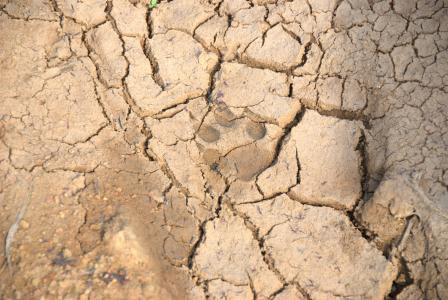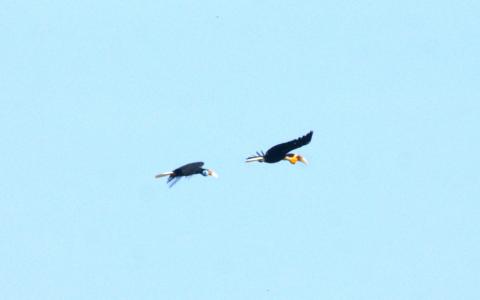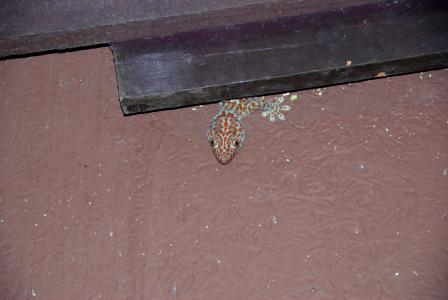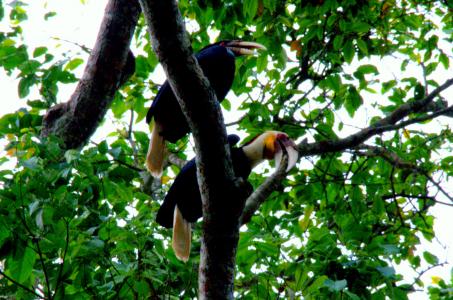In the Land Where Deer Bark and Dogs Whistle
By Sy Montgomery, Author and Naturalist
Author Sy Montgomery reports live from the field from Thailand’s Khao Yai National Park. Sy joined the Earthwatch expedition Tracking Asiatic Wild Dogs in Thailand alongside volunteers Roger and Parker Wood, a father-daughter photographer and videographer duo, and Earthwatch Communications Director Alix Morris. This post is the second in Sy’s field series. (Check out her first post here: “Worlds between Worlds.”)
Khao Yai National Park, Thailand — “TO-KAY! TO-KAY! TO-KAY!” It sounds like a bad tape recording of a very rude person yelling the same word over and over. But the voice greeting us upon arrival at our guesthouse at Thailand’s first national park belongs to a seven-inch gecko sporting skin spangled fiery orange against a blue-grey background and outsized hands that allow him, like magic, to cling to glass.
We’ve come to help study an animal even less known than this loudmouthed lizard. With their reddish coats and fluffy tails, Asiatic wild dogs, or dholes, look a bit like outsized foxes. But while the dhole may look vulpine, it is nothing like the familiar fox — or any other canid on Earth. Dholes don’t bark; they whistle. Extreme athletes, they can run 45 miles per hour and leap seven feet into the air from a standstill. They are reportedly strong enough to bring down a tiger. Yet even with such superpowers, the dhole remains obscure.
“Actually, most Thais don’t even know there are dholes in Thailand,” Dr. Nucharin Songsasen tells us. A research scientist with the Smithsonian Conservation Biology Institute, this 54-year-old Thai-born powerhouse – one of the two principal investigators on our Earthwatch expedition – was drawn, she said, “to study an animal nobody paid attention to.”
We’re all thrilled to help. Roger Wood, 55, a former senior director of product management for McAfee and Intel (now a professional brewer), has traveled extensively in Africa – but had no experience with Asian wildlife. The dhole study, he says, “seemed like a great species to fill that void.” He’s come with his daughter Parker, 20, a film student with a special focus on documentaries who’s got a black belt in karate. Filming the project was a great opportunity for both her and Earthwatch. Communications director Alix Morris is fascinated by the elusive nature of dholes. “Their lives are a mystery,” she said. “And who doesn’t love a good mystery?”
Those are my feelings exactly. Here’s a chance to not only work with an unknown and enigmatic species, but to do so at a spectacular park that also harbors wild elephants, sun bears and moon bears, strange little barking deer with pointy fangs called muntjacs, at least four species of hornbills, civets, gibbons, and macaques.
Unlike our American foxes, coyotes or wolves, there are no myths or stories about dholes in Thailand, Nucharin told us on the three-hour drive northeast of Bangkok to the park. Most people have never heard of them. Many foreigners don’t even know how to pronounce their name. At international conferences, Nucharin has, to her dismay, heard people calling them “Dee-holes.”
“In Thailand, elephants are more abundant than dholes,” she pointed out. And worldwide, tigers may be more abundant than dholes. Dog specialists consider dholes one of the least studied canids on earth, despite their endangered status.
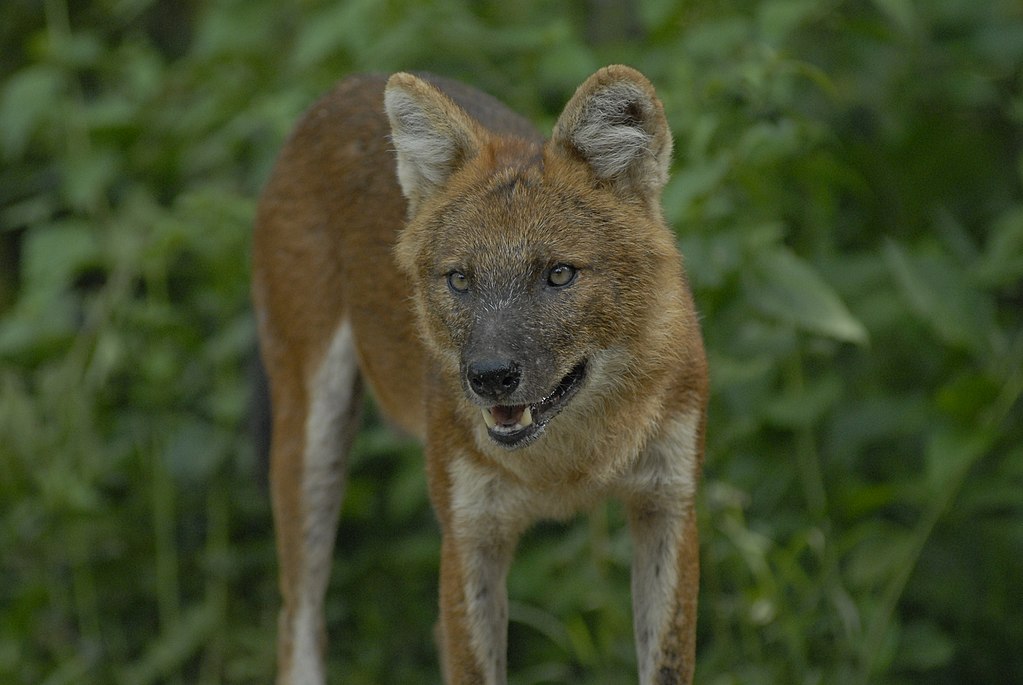
Once, dholes ranged from Russia to Kazakhstan, from Pakistan to Southeast Asia. Now, they are mainly restricted to some of the most restricted, degraded, and disconnected forest fragments on the planet. Conservationists fear dholes’ worldwide population may have declined by half since 2008.
This is why Nucharin began her project in 2007. Conserving dholes, she felt, should be an urgent conservation priority. And Thailand, along with India, is one of the world’s last strongholds for dholes. Khao Yai may be one of the best places in the country to see them.
When Nucharin began her study in eastern Thailand, it wasn’t easy. “Two years went by and I only laid eyes on one dhole,” she told us. Later, she worked at another site in Western Thailand where she met Dr. Ronglarp Sukmasuang – an associate professor in the Department of Forest Biology at Kasetsart University in Bangkok who was also trying to study dholes. But while Nucharin had made an important connection—Ronglarp is the other lead scientist for our Earthwatch expedition—she captured and radio-collared only one dhole, a female who was nursing.
But here at Khao Yai, “tourists actually see them,” Nucharin tells our team – and casual visitors have even watched these critically endangered canids hunting and killing prey. But to the researcher’s horror, she learned that tourists, and sometimes even park rangers, would throw stones at the dholes to chase them away from their prey.
Dholes are persecuted in part because of their hunting techniques. They don’t have the luxury of a 400-pound tiger, who can kill a large deer like a sambar with a relatively quick bite to the neck. Dholes often drive their prey into the water and kill it by eating it alive. “It’s because dholes are smaller than their prey,” she explains; but “it’s gruesome to see.”
(But who are we humans to criticize, when only recently a prince among our kind ordered a journalist be dismembered in his palace to silence his words? The prince didn’t even eat him.)
Even pet dogs have been known to run loose in packs through woods and kill deer alive as dholes do. And we humans love our dogs. Nucharin has three: one of them, Buddy the beagle, was one of the world’s first test tube puppies, one of seven produced by one of her students. A year later she adopted a hound-mix rescue, Aimee; and most recently an elderly golden retriever rescue, Sam, joined the family.
Roger and Parker, Alix, and I all live with dogs as well. But in our new home, too, we find animals calmly surrounding us. No sooner had I unpacked a photo of my border collie to adorn Alix’s and my room than Parker reported that a barking deer was staring at her through the window. Our first night, three giant Malayan porcupines approached within yards of the front door of the adjacent guest house. On our way back from seeing them, we discovered two more on our own lawn. Earlier research teams have had to wrest their rice cooker from the paws of one such porcupine, and another time a sambar deer munched a watermelon the team had been coveting all day. We’re warned to keep our windows locked during the day lest macaques steal our valuables.
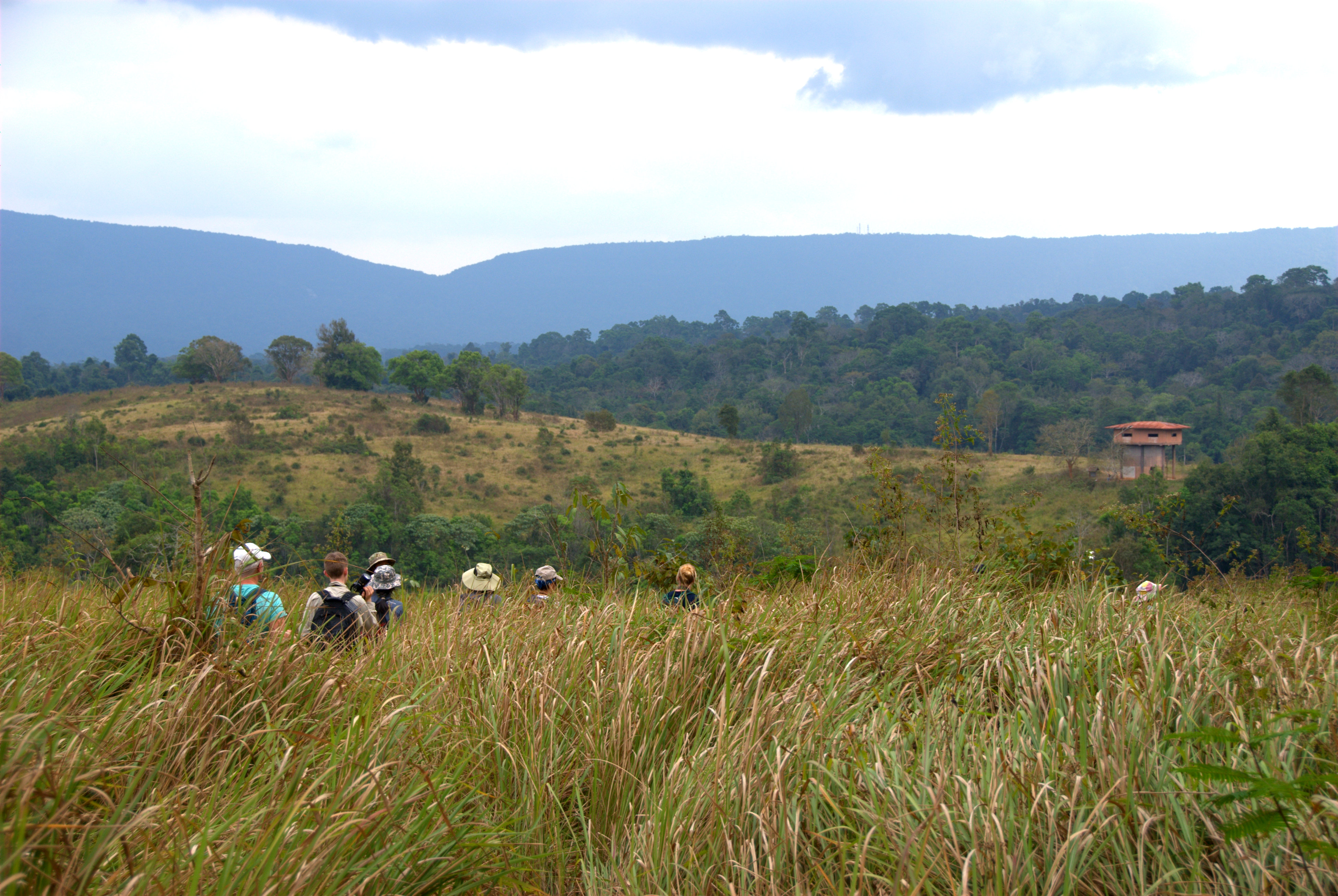
And here lies the reason that the dholes here may be easier to study than elsewhere. They live at the confluence of the human and animal worlds. Their prey finds safety from poachers and persecution near the guesthouses. Dholes have been seen hunting near the park’s gift shop and cafeteria. They are spotted often enough that Nucharin heard a rumor going around that Khao Yai supported 2,000 dholes! She thinks there are actually fewer than 100.
But how many they are—what they eat, where they travel, how they socialize—is still unknown. Nucharin and Ronglarp, with the help of lay people like us, may be the first to find out.
Last year, here at Khao Yai, her team saw dholes frequently. “That year was unusual,” she said. “Let’s hope we repeat that experience!”
We might get a chance to watch some of the most critically endangered canids on earth. Or we might not see dholes at all. Only one thing’s for certain: Here in a land where lizards yell, deer bark, and dogs whistle, anything might happen.
Learn more about Sy's trip in her next blog post, "Leech Socks, Lizards, and Bottles of Blood"
